Visit Old Town Malaga in the Costa del Sol
In this post we explore the Old Town of Malaga – a colorful city in the Costa del Sol’s southern region of Spain. It’s full of stunning architecture, historic castles, an expansive fortress or Alcazaba, scenic lookout points and an easy to walk central district filled with plazas, shopping venues and delicious tapa bars and restaurants to experience.
One of my favorite cities to explore in the Costa del Sol of Andalusia is Malaga, a perfect combination old and new, walkable areas, fantastic attractions, viewpoints and places of interest that makes an easy day trip using Malaga as a hub for travel.
Are you planning a trip to the sunny Costa del Sol in Spain? Málaga, the region’s exciting regional capital, serves as the main gateway to this Mediterranean paradise. Far more than just a transit point, this historic city deserves dedicated exploration with its remarkable blend of Moorish architecture, colorful cultural scene, and authentic Andalusian atmosphere
The Old Town of Malaga is called Centro Histórico de Málaga. This area is known for its charming narrow streets, historic buildings, cultural attractions, and vibrant atmosphere. It’s a popular destination for tourists visiting the city of Malaga, which is located in the Andalusia region of southern Spain.
Old Town Malaga: Tapas, Traditions, and Timeless Architecture – Spend a Perfect Day Wandering the Historic Center of town
I’ll share my favorite places to visit and some wonderful attractions to visit around Malaga’s historic district that is mostly a walkable part of the city to explore.
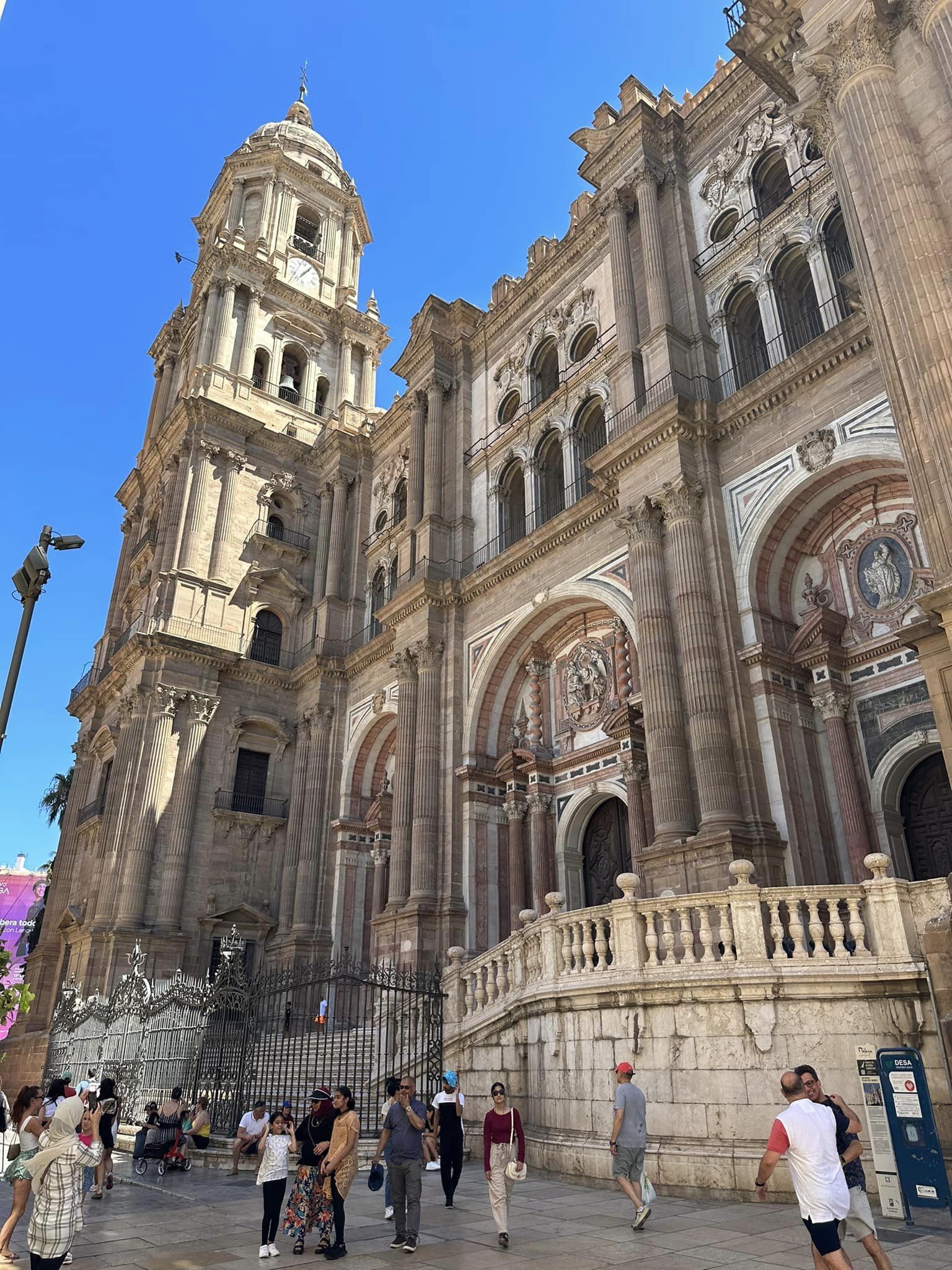
Where is the old town of Malaga city located?
The old town of Malaga city, also known as the “Malaga Old Town” or “Centro Historico” is located in the heart of the city of Malaga, which is situated in the southern part of Spain. It is the regional capital of the Costa del Sol with it’s main transport air and train hub located in the outskirts of the historic district. The Old town features most of the city’s cultural and historical attractions including: the main cathedral, bull ring,beautiful plazas, Roman Ruins, Alcazar and many promenades and shopping arcades to explore.
The old town is bordered by the Mediterranean Sea along the Costa del Sol with its picturesque harbor area beach areas and the old town. The historic center is characterized by narrow streets, historic architecture, and a rich cultural heritage that is well preserved and well maintained.
It’s a must-visit area for tourists exploring the city of Malaga and I’ll share all my favorite places to visit and explore in the city and surrounding area.
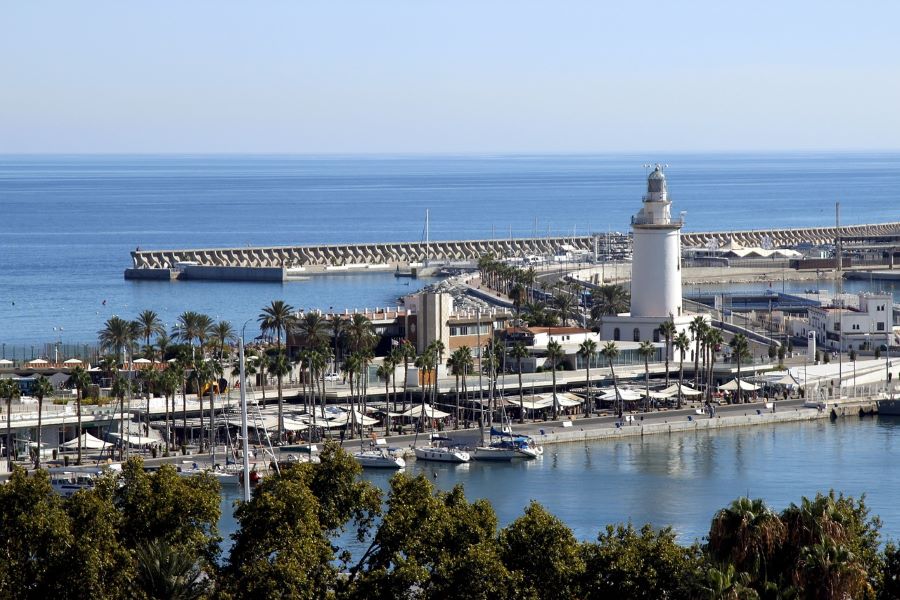
How to get around the old town of Malaga
The historic district is relatively compact and walkable with many walking only promenades that make easy to get to the many public squares, historic sites and shopping venues around the city. You can also public transportation by local buses and regional trains that are in the city and take you to outlying areas of the Costa del Sol.
From María Zambrano train station, it’s a 20-minute walk (1.7km) to the Cathedral at the heart of the historic district. For a faster option, take bus #1 or #19 from the station to Alameda Principal stop (€1.40, runs every 10 minutes, journey time 7 minutes). From the main bus station at Paseo de los Tilos, take bus #4 to Alameda Principal (€1.40, runs every 12 minutes). Alternatively, taxis and Ubers cost approximately €5-7 and take 5-8 minutes depending on traffic. and where you want to be dropped off.
Once there, most of the attractions, shopping, plazas center around the Malaga Cathedral and the maze of small narrow streets you can walk around easily in the many walking promenades, squares and attractions.
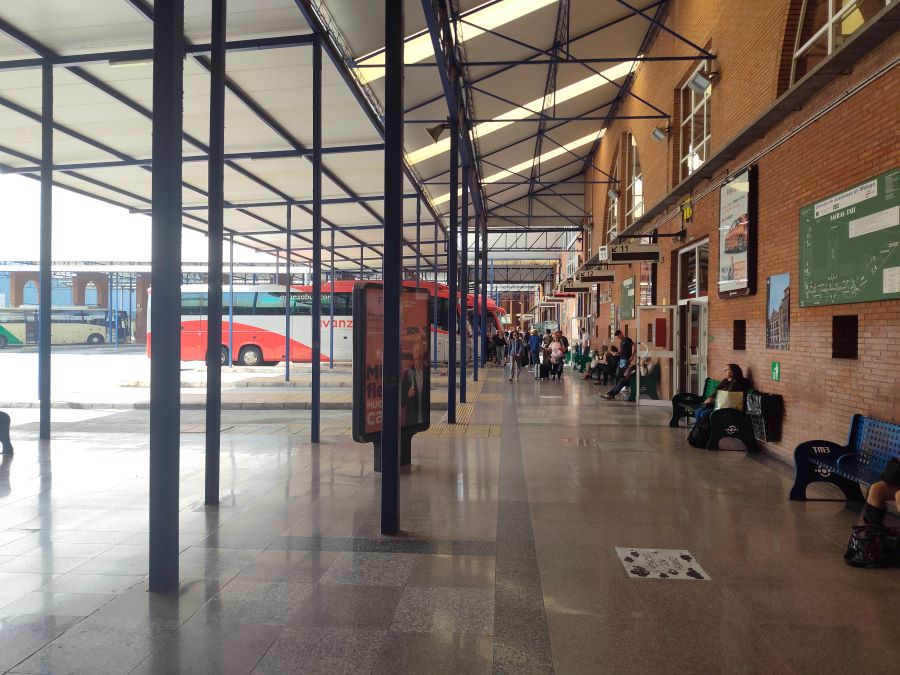
Get to the Old Town from the airport
If you want to get to the airport or to other outlying neighborhoods or beach communities or towns, there is a local train service called Cercanías Málaga. To get around via regional train, check out their main website at Renfe Cercanías Málaga
Getting from Málaga Airport (AGP) to the Old Town is easy, with several transport options depending on your budget and preference:
1. Train (Fast & Affordable)
- Duration: ~12 minutes
- Cost: ~€2
- Route: Take the C1 Cercanías train from Aeropuerto station to Málaga-Centro Alameda (the last stop).
- Frequency: Every 20 minutes from 6:30 AM to 11:30 PM.
- Best for: Quick and cheap travel with minimal hassle.
2. Bus (Cheapest Option)
- Duration: ~20–25 minutes
- Cost: ~€4
- Route: Take the A Express Bus from the airport to Alameda Principal, which is right by the Old Town.
- Frequency: Every 20–30 minutes.
- Best for: Budget travelers with light luggage.
3. Taxi / Uber / Bolt (Most Convenient)
- Duration: ~15 minutes
- Cost: ~€20–€25
- Best for: Direct, door-to-door service, especially with luggage.
4. Rental Car (Best for Further Travel)
- Duration: ~15 minutes (depending on traffic)
- Route: Take MA-21 into the city center.
- Best for: Travelers planning to explore beyond Málaga.
If you’re traveling light and want the quickest option, the train is the best choice. If you have a lot of luggage or prefer direct service, a taxi or Uber is more convenient.
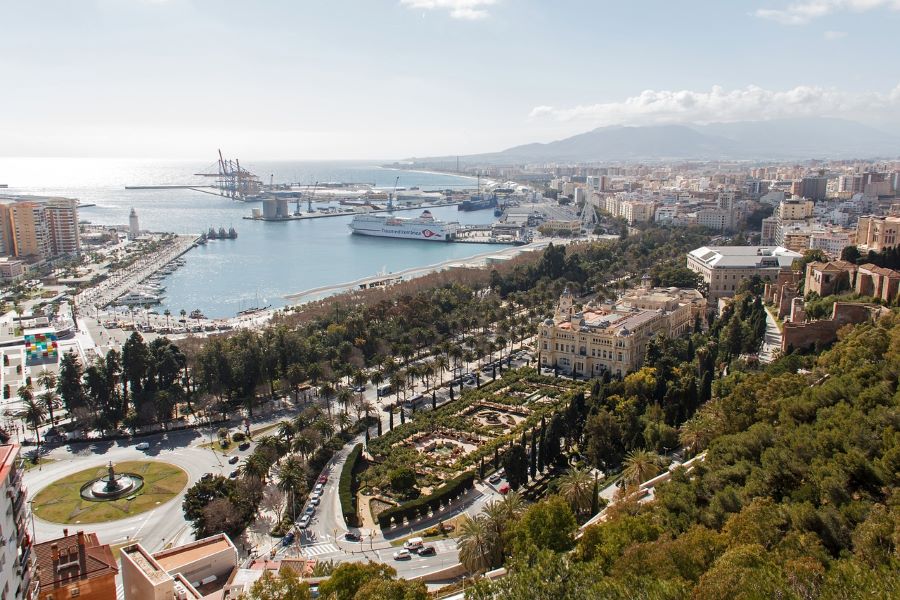
18 best places and attractions around Malaga city
Malaga city offers a wealth of attractions and places to visit, blending its rich history with modern amenities. Here are 18 top attractions and places to explore around Malaga city.
1. Alcazaba
I’m fascinated with the historic fortress of the Alcazaba located above the highest ridge in the city. The well-preserved Moorish fortress is fun to explore and learn about the significant Moorish influence to Andalusia duriing its hey day.. You can hike all the way up to the Gibralfaro Castle and check out the panoramic views around the city and the Mediterranean Sea. Built in the 11th century, it is one of the best-preserved Arab fortresses in Spain. The Alcazaba features beautiful gardens, intricate courtyards, and well-preserved walls and towers. Visitors can explore its historic architecture, including arches, fountains, and ornate details, as well as enjoy panoramic views of the city from its elevated position.
The Alcazaba, a remarkably preserved Moorish fortress, dates back to 1057 during the reign of Badis, the Berber King of the Taifa of Granada (according to Málaga’s Municipal Heritage Records). The Andalusian government’s Cultural Heritage Department recognizes it as one of Spain’s most intact Arab fortresses, with approximately 70% of its original structures still standing. My December 2024 visit revealed recent restoration work on the northeastern tower, completed under the supervision of archaeologist Manuel Acién Almansa.
Hours, costs and details to visiting Malaga Alcazaba
The Alcazaba of Málaga is a prominent Moorish fortress-palace situated in the city’s historic center, adjacent to the Roman Theatre. It’s renowned for its well-preserved Islamic architecture, lush gardens, and panoramic views of Málaga. Here’s what you need to know for your visit:
Opening Hours
- Summer (April 1 – October 31): 9:00 AM – 8:00 PM
- Winter (November 1 – March 31): 9:00 AM – 6:00 PM
- Last Entry: 45 minutes before closing
Note: The Alcazaba is open daily throughout the year.
Admission Fees
- Standard Ticket: €3.50
- Reduced Ticket: €1.50
- Applicable for students, retirees, individuals with disabilities over 33%, and children over 6 years of age
- Group Rate (10+ people): €2.50 per person
- Combined Ticket (Alcazaba + Gibralfaro Castle): €5.50 standard, €2.50 reduced, €4.00 group (Alcazaba y Castillo de Gibralfaro)
Children under 6 years of age enter free.
Free Entry
Enjoy free admission every Sunday after 2:00 PM.
What to Expect
- Historical Significance: Built in the 11th century during the Hammudid dynasty, the Alcazaba served as a defensive stronghold and residence for Muslim rulers.
- Architectural Features: Explore its double walls, fortified gates like the Puerta de los Arcos, and inner courtyards adorned with fountains and gardens.
- Scenic Views: The fortress offers sweeping vistas of Málaga’s cityscape, harbor, and surrounding hills.
Location & Contact
- Address: Calle Alcazabilla, 2, 29012 Málaga, Spain
- Phone: +34 952 22 72 30
- Official Website: alcazabaygibralfaro.malaga.eu
Further Reading – Check out my post on visiting the Alcazaba of Malaga for more inspiration.
Check out this fun walking 4K tour of the Alcazaba of Malaga below
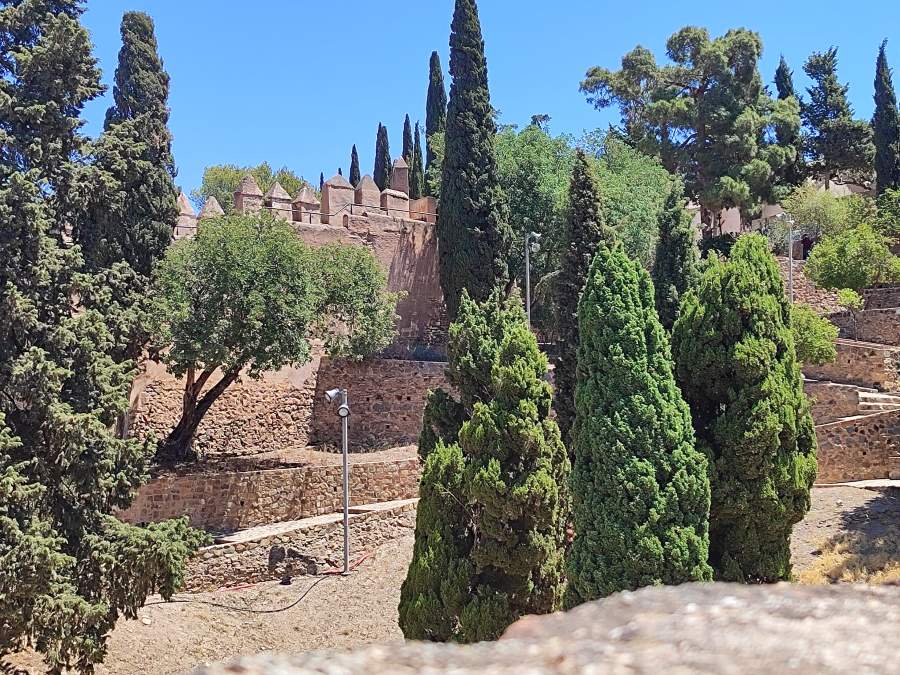
2. Gibralfaro Castle
Gibralfaro Castle is perched on a hill overlooking Malaga and offers breathtaking panoramic views of the city, the Mediterranean Sea, and the surrounding landscapes. Originally constructed in the 14th century as a defensive fortress, the castle is connected to the Alcazaba by a historic pathway. Visitors can explore its sturdy battlements, towers, and walls, while also learning about its history and significance in the region. The hike up to Gibralfaro Castle is a popular activity for those seeking both historical exploration and stunning vistas of Malaga.
Visiting Castillo de Gibralfaro offers a panoramic glimpse into Málaga’s rich history and scenic beauty. Here’s a comprehensive guide to help you plan your visit:
Opening Hours
- Summer (April 1 – October 31): 9:00 AM – 8:00 PM
- Winter (November 1 – March 31): 9:00 AM – 6:00 PM
- Last Entry: 45 minutes before closing time
The castle is open daily throughout the year. (castillodegibralfaro.com)
Admission Fees (2024)
- Standard Ticket: €3.50
- Combined Ticket (Gibralfaro + Alcazaba): €5.50
- Reduced Ticket: €1.50
- Applicable for students, retirees, individuals with disabilities over 33%, and children over 6 years of age
- Group Rates (10+ people):
- Single Monument: €2.50
- Combined: €4.00
Free Entry on Sundays
Enjoy free admission every Sunday after 2:00 PM.
What to Expect
- Historical Significance: Originally built in the 14th century to protect the Alcazaba, the castle offers insights into Málaga’s military past.
- Panoramic Views: Walk along the fortress walls for sweeping views of Málaga city, the harbor, and, on clear days, the Strait of Gibraltar.
- Interpretation Centre: Discover exhibits featuring military artifacts, historical documents, and models depicting the castle’s evolution.
- Amenities: On-site facilities include restrooms and a small café offering refreshments.
Getting There
- On Foot: A scenic 20-minute uphill walk via two main routes:
- Mundo Nuevo: A steeper path through Mediterranean vegetation.
- Paseo de Don Juan de Temboury: A gentler incline with historic walls and city views.
- By Bus: Take Bus No. 35 from Paseo del Parque or Plaza de la Marina directly to the castle entrance.
- By Car: Limited parking is available near the entrance; it’s advisable to arrive early during peak seasons.(castillodegibralfaro.com)
Location
- Address: Camino de Gibralfaro, 11, 29016 Málaga, Spain
Check out my post on Historic Gibralfaro Castle for more inspiration.
Here’s a quick walking tour of the Gibralfaro Castle, ramparts and views for inspiration below
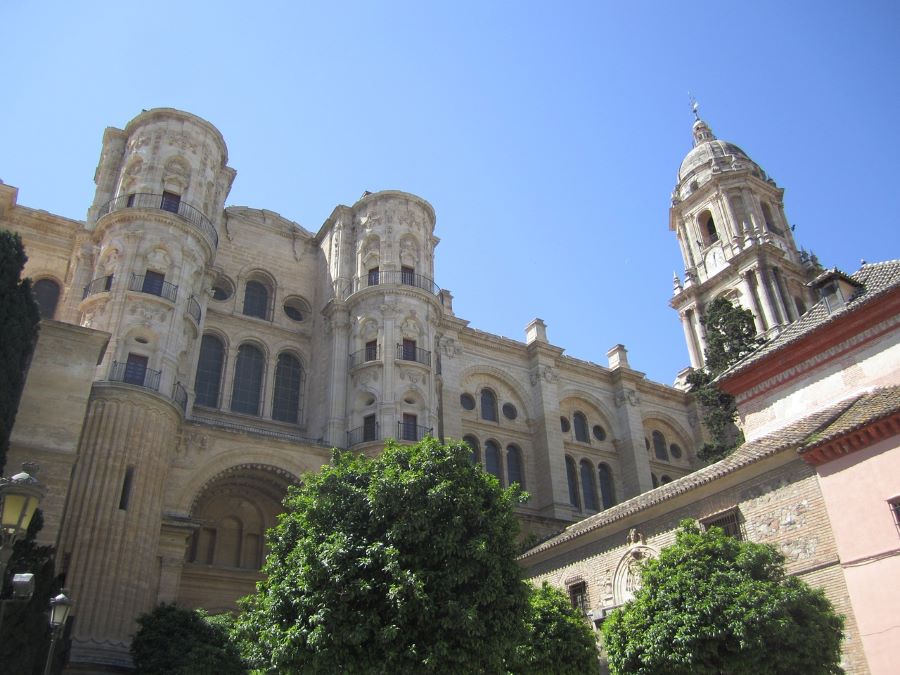
3. Malaga Cathedral
Visit the stunning Malaga Cathedral, also known as La Manquita due to its one unfinished tower. Its interior is equally impressive with ornate chapels and sculptures. This stunning cathedral is known for its unique appearance, with one of its towers remaining unfinished, hence the nickname.
Key features of Malaga Cathedral include its elaborate Renaissance and Baroque architectural style, intricate facades adorned with detailed sculptures, and an opulent interior with ornate chapels, altarpieces, and religious artwork. The cathedral is an iconic symbol of the city and a must-visit attraction for its historical and artistic significance. Visitors can explore its rich history and admire the craftsmanship that went into its construction.
Hours, costs and details to visiting Malaga Cathedral
Here’s a practical guide to visiting Málaga Cathedral (Catedral de la Encarnación), including hours, ticket prices, and key details:
Opening Hours
Cathedral Interior:
- Monday to Friday: 10:00 AM – 8:00 PM
- Saturday: 10:00 AM – 6:00 PM
- Sunday: 2:00 PM – 6:00 PM
Note: Last entry is 45 minutes before closing. (malagacatedral.com)
Free Entry Times (Cathedral Only):
- Monday to Saturday: 8:30 AM – 9:00 AM
- Sunday: 8:30 AM – 9:30 AM(malagacatedral.com)
Free access does not include the audio guide and is valid only for the Cathedral. (malagacatedral.com)
Admission Prices
Cathedral Only:
- General Admission: €10.00
- Seniors (65+): €9.00
- Juniors (13–17 years): €6.00
- Students (18–25 years): €7.00
- Groups (15+ people): €7.00 per person
- School Groups (under 12 years): €4.00 per person
- Residents of Málaga, children under 13, and individuals with disabilities:
All tickets include a free audio guide available in multiple languages.
Cathedral + Virtual Reality (VR) Experience:
- General Admission: €15.00
- Seniors (65+): €13.00
- Juniors (13–17 years): €9.00
- Students (18–25 years): €10.00
- Groups (15+ people): €10.00 per person
- Residents of Málaga: €5.00
Highlights & Visitor Tips
- Architectural Styles: The Cathedral showcases a blend of Gothic, Renaissance, and Baroque styles.
- “La Manquita”: The Cathedral is nicknamed “La Manquita” (“The One-Armed Lady”) due to its unfinished south tower.
- Choir Stalls: Intricately carved by Pedro de Mena, these are considered masterpieces of Spanish Baroque wood sculpture.
- Accessibility: The Cathedral is accessible for visitors with reduced mobility via the lateral entrance near the Patio de los Naranjos on Cister Street.
Location & Contact
- Address: Calle Molina Lario, 9, 29015 Málaga, Spain
- Phone: +34 952 22 03 45
Further reading – Check out my post Explore Malaga Cathedral for more inspiration.
Here’s a visit to Malaga Cathedral and the gorgeous interior and chapels of this magnificent structure on this video tour
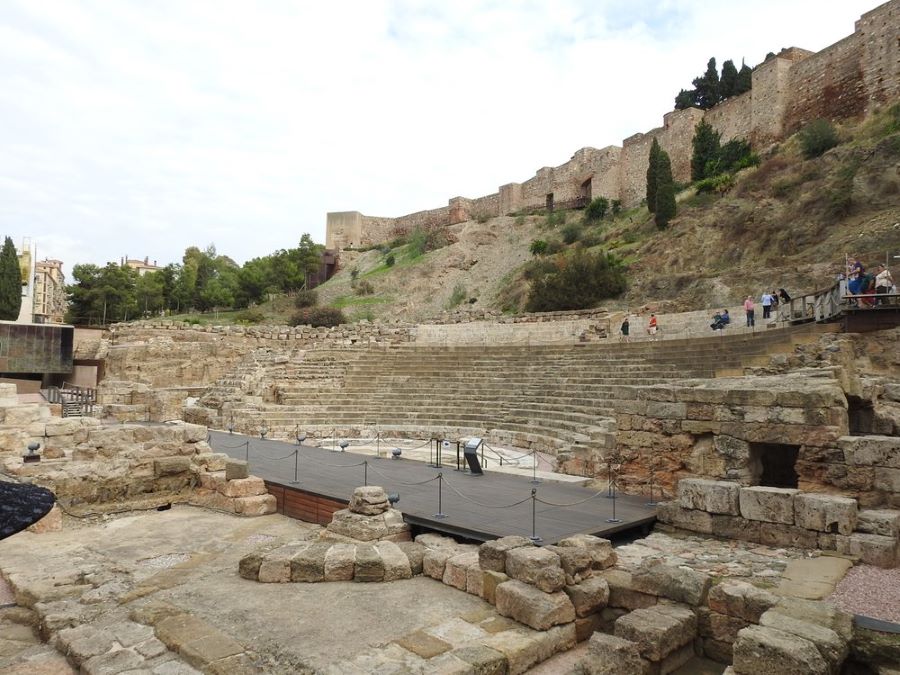
4. Roman Theater
Discover the ancient history of Malaga by visiting the Roman Theater, which dates back to the 1st century BC during Emperor Augustus reign and is located at the base of the Alcazaba.
Visitors to the Roman Theater can explore its well-preserved ruins, including the seating area, stage, and various architectural elements that provide insights into Roman entertainment and architecture. The theater’s historical significance and its connection to the broader history of Malaga make it a fascinating attraction for history enthusiasts and those interested in ancient civilizations.
Opening Hours
Interpretation Centre & Theatre Access:
- Tuesday to Saturday: 10:00 AM – 6:00 PM
- Sunday & Public Holidays: 10:00 AM – 4:00 PM
- Closed: Mondays (except public holidays)
Note: Last admission is 30 minutes before closing.
Admission
- Entry: Free for all visitors.
Visitor Highlights
- Interpretation Centre: Offers exhibits on the theatre’s history, Roman Málaga (Malaca), and the site’s excavation.
- Theatre Structure: Features a semicircular seating area (cavea), orchestra, and stage (proscaenium), showcasing Roman architectural design.
- Glass Walkways: Allow visitors to walk over and view the ruins without causing damage.
Location & Contact
- Address: Calle Alcazabilla, 8, 29015 Málaga, Spain
- Phone: +34 951 92 60 20
- Website: Teatro Romano de Málaga
Here’s a quick tour of the main parts/attractions of the Roman Theater to explore below
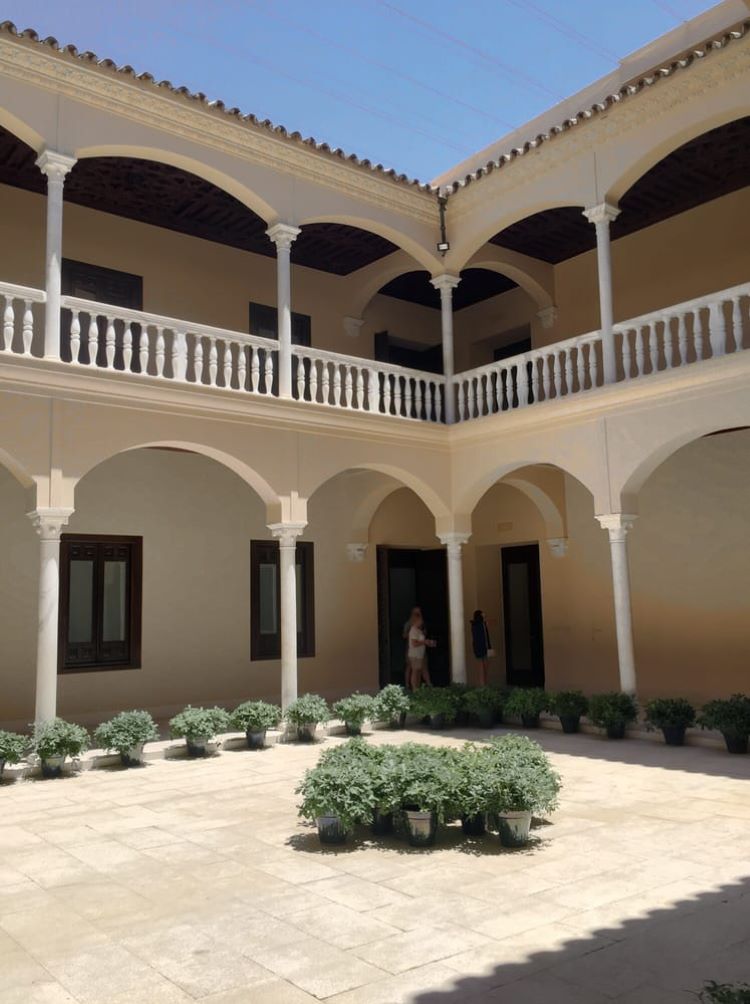
5. Picasso Museum
As the birthplace of Pablo Picasso, Malaga is home to a museum dedicated to his life and an extensive collection of his works, including paintings, drawings, and sculptures.
Visitors to the museum can explore the various stages of Picasso’s artistic career, from his early years to his later masterpieces. The museum provides valuable insights into Picasso’s creative evolution and his deep connection to Malaga, his hometown. It is a must-visit destination for art enthusiasts and anyone interested in the life and legacy of one of the most influential artists of the 20th century.
Hours, costs and details to visiting
Opening Hours
- March – June: 10:00 AM – 7:00 PM
- July – August: 10:00 AM – 8:00 PM
- September – October: 10:00 AM – 7:00 PM
- November – February: 10:00 AM – 6:00 PM
Last entry is 30 minutes before closing. The museum is open daily.
Admission Fees
- General Admission: €13
- Reduced Admission: €11
- Available for seniors over 65, European Youth Card holders, and students under 26.
- Free Admission:
- Children under 17
- Persons with disabilities (and one companion
Exhibitions & Features
- Permanent Collection: “Pablo Picasso: Structures of Invention” showcases 144 works, offering insight into Picasso’s creative evolution.
- Temporary Exhibitions: Rotating exhibits featuring works by Picasso and other artists.
- Architecture: The museum is housed in the 16th-century Palacio de Buenavista, blending Renaissance and Mudéjar elements.
Location & Contact
- Address: Calle San Agustín, 8, 29015 Málaga, Spain
- Phone: +34 952 12 76 00
- Email: [email protected]
- Website: museopicassomalaga.org(museopicassomalaga.org
Getting There
- On Foot: Located in Málaga’s historic center, near the Cathedral, Alcazaba, and Roman Theatre.
- By Bus: Nearest stops are Paseo del Parque-Ayuntamiento and Plaza de la Merced.
- By Car: Closest public parking is available at Plaza de la Marina and Alcazaba.
Audio Guide
The museum offers a free audio guide accessible via a web app on your mobile device, available in multiple languages, including Spanish, English, German, French, Italian, Portuguese, Russian, Chinese, Japanese, Korean, Arabic, Basque, Catalan, and Galician.
Here’s a quick visit and highlights of visiting the Picasso Museum and his influences of folk art of Spain
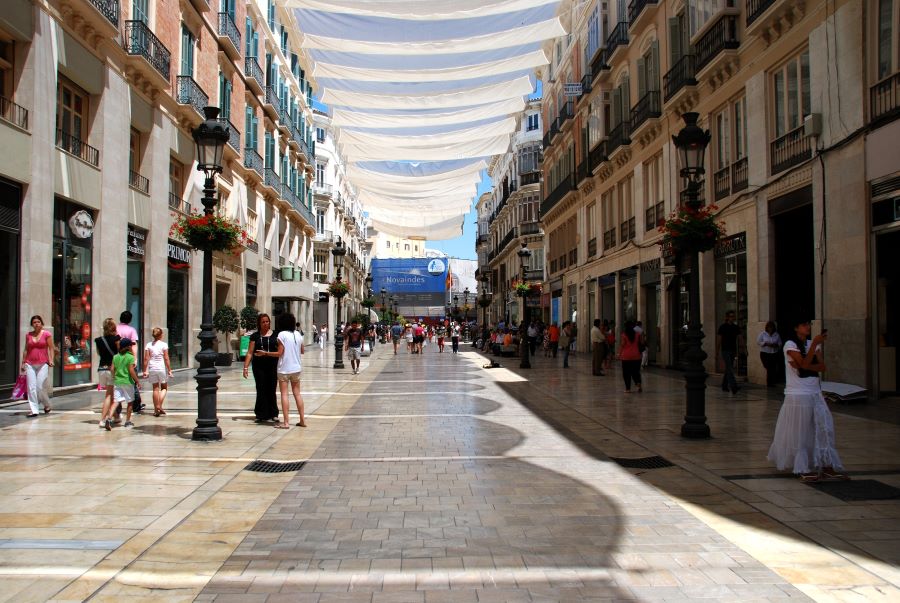
6. Calle Lario
Explore Calle Larios, Malaga’s main shopping street, known for its elegant boutiques, cafes, and vibrant atmosphere. It is known for its elegant and pedestrian-friendly design, with charming, wide promenades lined with an array of upscale boutiques, shops, cafes, and restaurants.
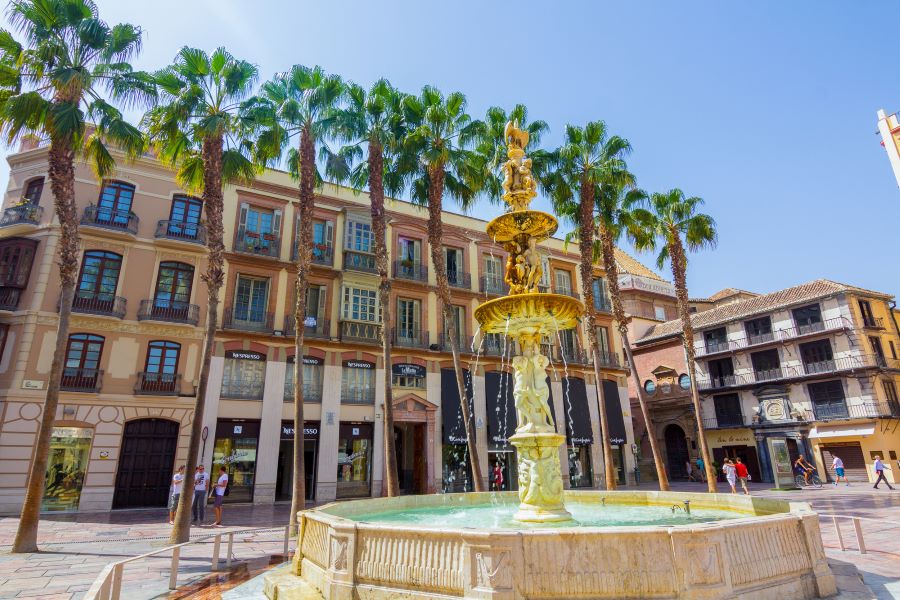
7. Plaza de la Constitution
Plaza de la Constitution, often referred to simply as Constitution Square, is the main square and a central gathering place in the heart of Malaga, Spain. It is located in the historic city center, making it one of the most prominent and bustling spots in the city.
This lively square is known for its charming architecture, including historic buildings with ornate facades, balconies adorned with flowers, and outdoor cafes. It serves as a hub for social and cultural activities, as well as a venue for various events and celebrations.
Plaza de la Constitution is particularly famous for its picturesque Christmas lighting and decorations, which transform it into a magical destination during the holiday season. It is a vibrant and vibrant space where locals and tourists come together to enjoy the lively atmosphere, dine at outdoor restaurants, and soak in the cultural heritage of Malaga’s historic center.
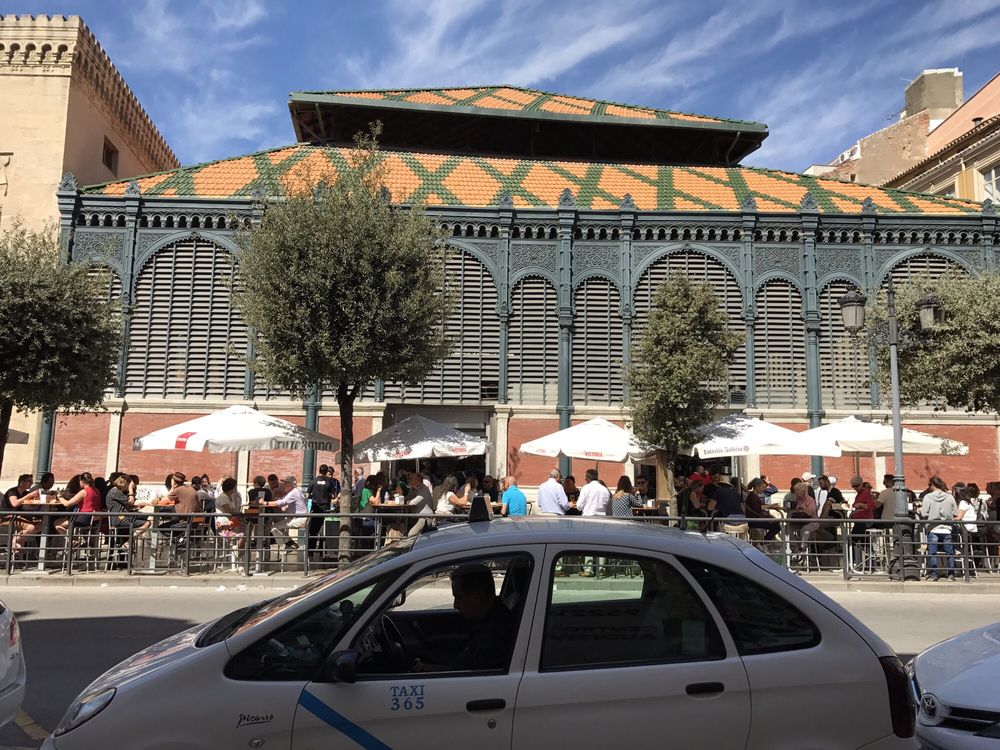
8. Atarazanas Market
Visit the historic Atarazanas Market, a bustling food market where you can sample fresh seafood, fruits, and local delicacies.
Visitors to Atarazanas Market can explore the stalls operated by local vendors, offering a wide selection of both traditional Spanish and international foods. It’s an ideal place to sample local delicacies, shop for fresh ingredients, or simply immerse yourself in the local culinary culture. The market reflects the rich gastronomic traditions of Malaga and is a must-visit for food enthusiasts.
Open Hours
Mon – Sat : 9:00 – 14:00
Sun : closed
Address: C. Atarazanas, 10, Distrito Centro, 29005 Málaga, Spain
Here’s a colorful video tour of the interiors of the market, the gorgeous stands and specialty foods you’ll find at the Ataranzas market
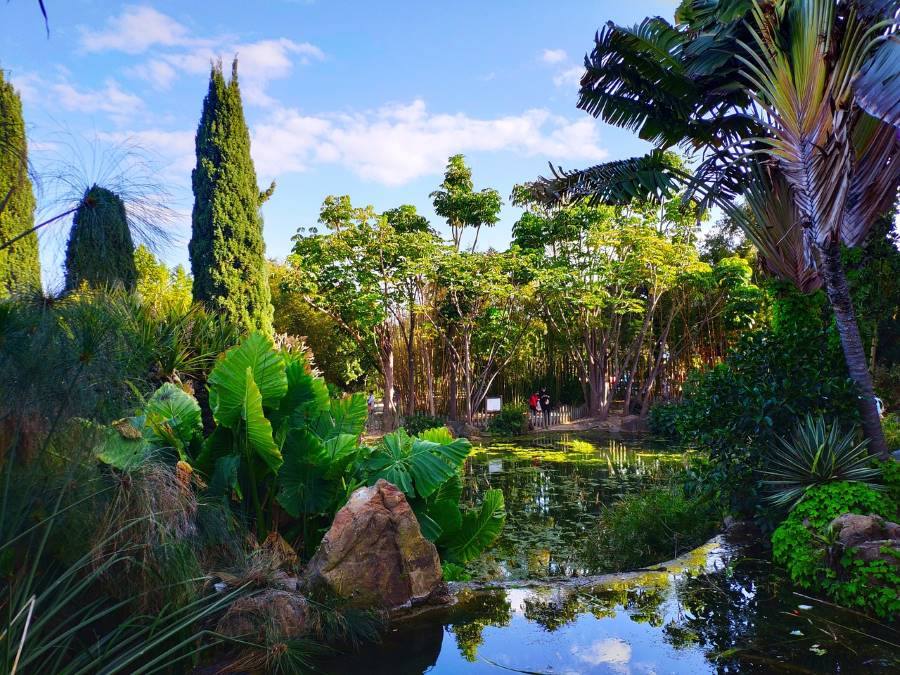
9. Malaga Park
Stroll through the beautiful Malaga Park (Parque de Malaga), a lush green space featuring fountains, sculptures, and tropical gardens.
Key features of Malaga Park include lush gardens, shaded pathways, ornate fountains, and a central promenade lined with palm trees. Visitors can stroll along its meandering paths, enjoy picnics on the lawns, or simply unwind in the serene ambiance of the park. The park also offers views of the port and the Mediterranean Sea, making it a delightful spot for a leisurely walk or a peaceful retreat in the midst of the city.
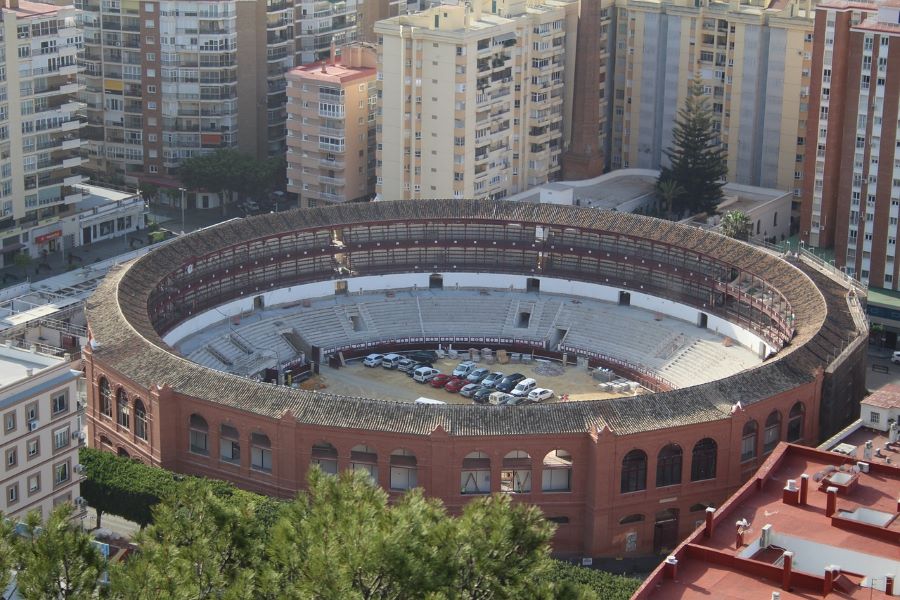
10. Bullring and Bullfighting Museum
Explore the Plaza de Toros de la Malagueta and the adjacent Bullfighting Museum to learn about this controversial tradition in Spain. Located in the Plaza de Toros de la Malagueta, this historic bullring offers a unique opportunity to explore the art, history, and significance of bullfighting in Spanish culture.
Visitors to the Bullring and Bullfighting Museum can tour the facilities, including the bullring itself, and gain insights into the various aspects of bullfighting, such as the matadors, the bulls, and the ritualistic performances. The museum also houses a collection of bullfighting memorabilia, costumes, and artwork related to this controversial and deeply ingrained Spanish tradition, making it an educational and thought-provoking experience for those interested in Spanish culture and history.
Address: Paseo Reding, s/n, Plaza De Toros De La Malagueta, Puerta 10, 29016 Malaga, Spain.
Telephone (+34)687 739 032
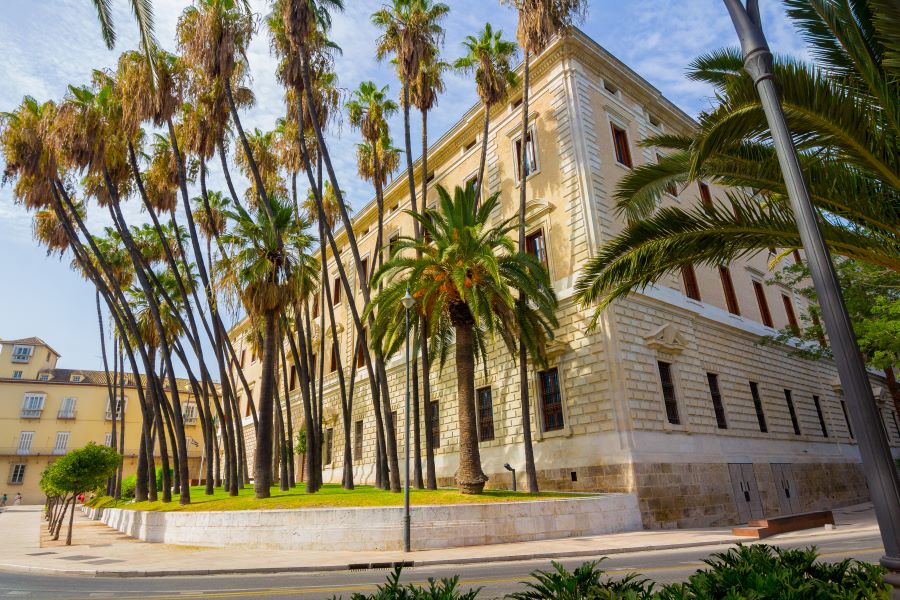
11. Aduana Palace
The Aduana Palace, also known as the Customs Palace or Palacio de la Aduana in Spanish, is a neoclassical architectural gem located in the heart of Malaga, Spain. It occupies a prominent position in the city center, overlooking the port of Malaga.
This historic palace was constructed in the 18th century and has served various purposes throughout its history, including as a customs house and a government building. Today, it houses the Malaga Museum, which showcases a wide range of art and historical exhibitions, providing insights into the rich cultural heritage of Malaga and the surrounding region.
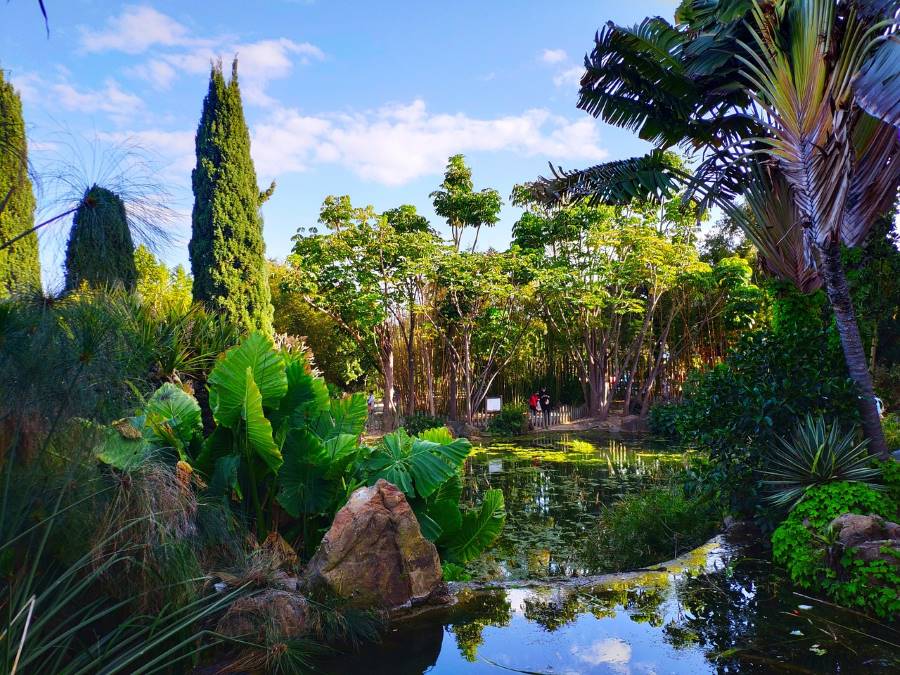
12. La Concepción Botanical and Historical Garden
Enjoy the peaceful ambiance of this botanical garden, known for its exotic plant collections and historical significance.
The garden is celebrated for its lush and diverse plant collections, including exotic tropical and subtropical species from around the world. Established in the 19th century, it offers a captivating blend of botanical exploration and historical significance, with meandering paths, water features, and stunning landscapes. Visitors can immerse themselves in the natural beauty of the garden while learning about its rich heritage, making it a wonderful destination for nature enthusiasts and history lovers alike.
Here’s a video tour of the lush botanical garden at La Concepcion below, definitely worth a visit

13. Muelle Uno
This modern waterfront shopping and dining complex offers a pleasant place to relax by the harbor, with shops, restaurants, and scenic views. Located in the port / harbor area of Malaga, this is a wonderful place to find some cool shops, eateries and enjoy the views or walk along the promenade waterfront areas
If you want to explore more about the shopping, dining and attractions at Muelle Uno, check out their website here for more information.
Here’s a fun video walking tour of the lovely harbor area and Muelle Uno area of Malaga below
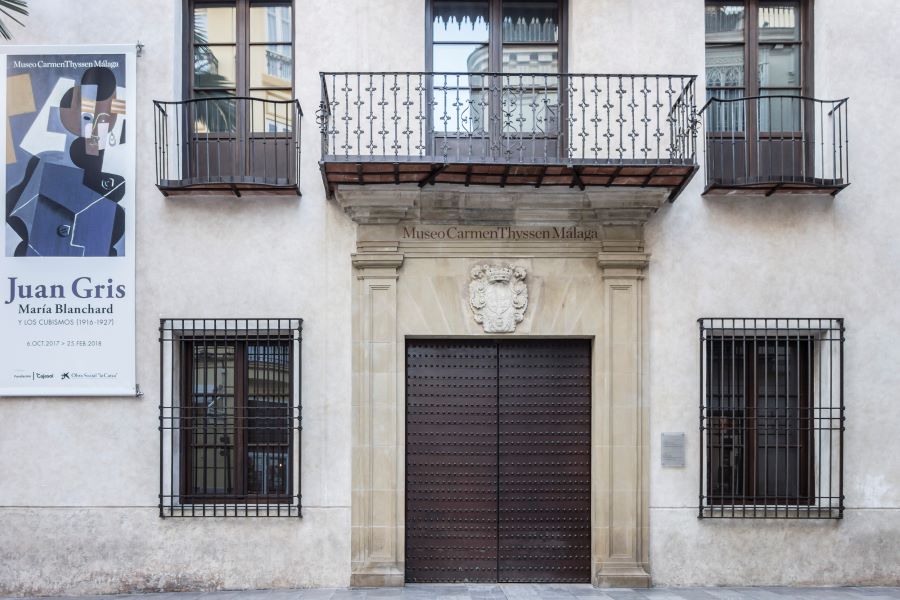
14. Museo Carmen Thyssen
The Museo Carmen Thyssen, also known as the Carmen Thyssen Museum in English, is an art museum situated in the heart of Malaga, Spain. It is located on the historic Calle Compañía, near the city’s main attractions and cultural sites.
This museum houses the Carmen Thyssen-Bornemisza Collection, which features a remarkable array of 19th-century Spanish art. Visitors to the museum can explore a diverse collection of paintings, including landscapes, regional scenes, portraits, and genre paintings. The artworks on display offer a comprehensive overview of Spanish art from the 19th century, showcasing the evolution of artistic styles and themes during this period.
Hours, costs and details to visiting
Opening Hours
- Tuesday to Sunday: 10:00 AM – 8:00 PM
- Closed on Mondays, except public holidays
- Special Hours:
- December 24 & 31: 10:00 AM – 3:00 PM
- Closed on December 25, January 1 & 6
Last admission is 30 minutes before closing.
Admission Fees
- General Admission: €12
- Reduced Admission: €8
- Available for seniors (65+), students under 26, European Youth Card holders, residents of Málaga province, and large families (3+ children)
- Group Admission: €10
- For groups of 6 to 20 people
All tickets include access to both the permanent collection and temporary exhibitions, along with an audio guide
Free Admission
- Every Sunday: from 4:00 PM
Additionally, free entry is granted to minors under 18, accompanied minors under 13, persons with disabilities (33% or higher), registered unemployed individuals, University of Málaga students, accredited teachers and students of Fine Art or Art History, official guides, accredited journalists, and ICOM members.
Exhibitions & Features
- Permanent Collection: Focuses on 19th-century Spanish painting, especially Andalusian works, featuring artists like Sorolla, Zuloaga, and Romero de Torres
- Temporary Exhibitions: Regularly updated online regarding show and calenda
Guided Tours & Amenities
- Guided Tours: Available in multiple languages; prior booking required via +34 952 217 511 or [email protected]
- Audio Guides: Free, accessible via smartphone or museum-provided devices
- Facilities:
- Free Wi-Fi
- Cloakroom
- Café offering a 10% discount with museum ticket
- Museum shop with art books, posters, and unique gifts
Accessibility
- Wheelchair access and adapted restrooms
- Free loan of wheelchairs, walking sticks, and baby carriers
- Sign language guides and audio descriptions for self-guided tours
- Reserved spaces in the auditorium for wheelchair users
Location & Contact
- Address: Plaza Carmen Thyssen, Calle Compañía, 10, 29008 Málaga, Spain
- Phone: +34 952 217 511
- Email: [email protected]
- Website: carmenthyssenmalaga.org(carmenthyssenmalaga.org)
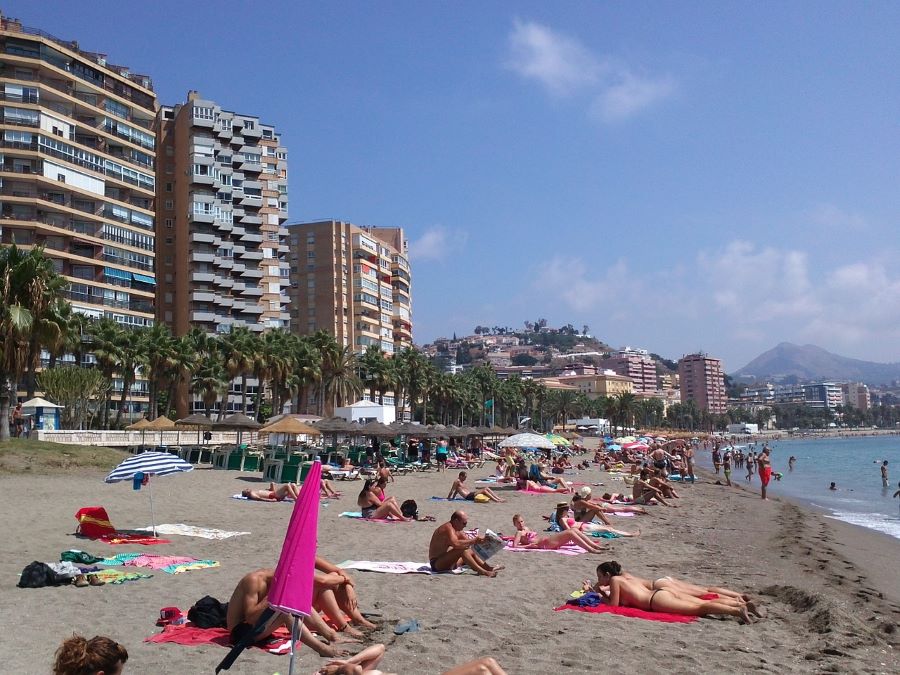
15, Malaga Beaches
You can spend some time at the city’s popular urban beaches, such as the easy to get to Playa de la Malagueta, for sunbathing, swimming, and water sports. It’s a fun and relaxing day on the beach or walk along the promenades and grab a bite along the way. Playa de la Malagueta, stretches for 1.2km and has earned Blue Flag status for its water quality and facilities. The beach offers rental sunbeds (€5/day), umbrella services, and water sports rentals including paddleboards (€15/hour) and jet skis (€60/30 minutes). The palm-lined promenade features numerous chiringuitos (beach restaurants) where you can sample local specialties like espetos (grilled sardines on skewers) for €7-10.
Málaga offers a string of easily accessible beaches right along the city’s coastline, making it simple to enjoy a beach day without going far. La Malagueta is the most popular, located just east of the port and backed by a lively promenade with cafes and chiringuitos serving fresh seafood. It’s clean, family-friendly, and close to the city center. A little further east, Playa de la Caleta tends to be a bit quieter with a more local vibe and a long stretch of sand great for relaxing or jogging. Pedregalejo Beach, in an old fishing village area, is known for its laid-back feel and excellent beachfront restaurants grilling sardines over open fires. For a more chilled-out vibe, Playa del Palo has a slower pace and a mostly local crowd. All of these are reachable by bus, bike, or even on foot depending on where you’re staying, making Málaga a very beach-accessible city.
Check out my post on visiting the beaches of Malaga here for a fun beach day or exploration of the area.
Take a video beach tour of some beaches to explore around the Malaga area below

16. Automobile and Fashion Museum
Car enthusiasts will appreciate the impressive collection of vintage cars, while the fashion museum showcases haute couture and clothing from various eras. It is situated in the heart of the city, making it easily accessible to visitors.
This unique museum showcases a remarkable collection of vintage cars, including rare and iconic automobiles from different eras. Car enthusiasts can admire the craftsmanship and design of these vehicles, which represent the evolution of automotive engineering and style.
In addition to the automotive section, the museum boasts a fashion museum that displays a wide range of clothing, accessories, and haute couture items from various periods in history. It offers a glimpse into the world of fashion and how it has evolved over time.
Opening Hours
- Monday to Sunday: 10:00 AM – 2:30 PM and 4:00 PM – 7:00 PM
- Special Hours:
- December 24 & 31: 10:00 AM – 2:30 PM
- Closed: December 25 and January 1
- Last Admission: 30 minutes before closing (
Admission Fees
- Adults (17–64 years): €10.00
- Seniors (65+): €8.00
- Youth (6–16 years): €6.00
- Students, Teachers, Unemployed, ICOM Members, Large Families, Groups (15+ people): €6.00
- Children under 6: Free
Exhibitions & Features
- Vintage Car Collection: Over 90 meticulously restored vehicles from brands like Rolls-Royce, Ferrari, Bentley, and Bugatti, spanning from 1898 to the present day.
- Haute Couture Fashion: More than 200 pieces from renowned designers such as Chanel, Dior, Balenciaga, and Schiaparelli, displayed in thematic rooms.
- Themed Rooms: 13 distinct areas showcasing the evolution of automotive design and fashion trends.
- EcoMuseum: A section dedicated to sustainable mobility, featuring early electric and steam-powered vehicles.
Location & Contact
- Address: Avenida Sor Teresa Prat, 15, 29003 Málaga, Spain
- Phone: +34 951 137 001
- Email: [email protected]
- Website: museoautomovilmalaga.com(www.tickets-malaga.com, Visita Andalucía)
Getting There
- By Bus: Lines 3, 15, 16, and 19 stop near the museum.
- By Metro: Line 2 to “Princesa-Huelin” station, followed by a short walk.
- By Car: Accessible via the A-7 highway; parking is available near the museum.
Visitor Tips
- Recommended Visit Duration: Plan for 1.5 to 2 hours to fully enjoy the exhibits.
- Photography: Allowed without flash; tripods are not permitted.
- Accessibility: The museum is wheelchair accessible, with elevators and adapted restrooms.
- Amenities: On-site café available for refreshments.
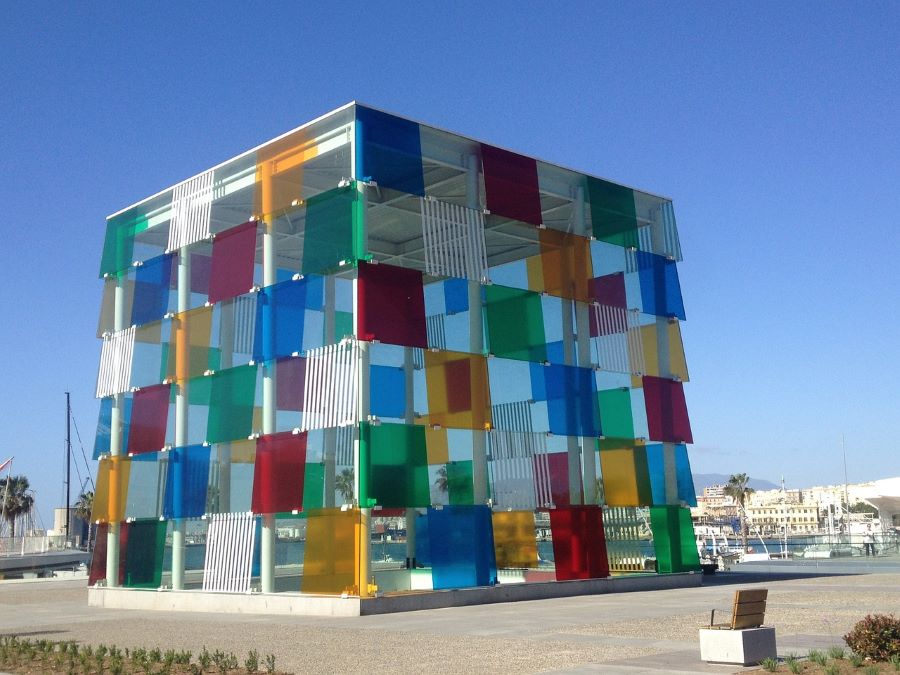
17. Centre Pompidou Malaga
The Centre Pompidou Málaga is a contemporary art museum located in the city’s port area, Muelle Uno. It is the first international branch of the famous Centre Pompidou Paris and is housed in a striking, multicolored glass cube known as El Cubo. The museum features a rotating selection of modern and contemporary art from the Pompidou’s extensive collection, including works by Picasso, Miró, and Frida Kahlo. Alongside its permanent collection, it hosts temporary exhibitions, workshops, and cultural events. Its waterfront location makes it a great stop for art lovers exploring Málaga’s vibrant cultural scene.
Hours, costs and details to visiting
Opening Hours
- Monday, Wednesday to Sunday: 9:30 AM – 8:00 PM
- Closed: Tuesdays, January 1, and December 25
- Special Hours:
- December 24 & 31: Open until 3:00 PM (last admission at 2:30 PM)
- Last Admission: 30 minutes before closing
Admission Fees
- Combined Ticket (Semi-permanent + Temporary Exhibitions): €9
- Semi-permanent Exhibition Only: €7
- Temporary Exhibition Only: €4
- Reduced Rates:
- Combined: €5.50
- Semi-permanent: €4
- Temporary: €2.50
- Applicable for seniors (65+), students up to 26 years, large families, and participants in University of Málaga congress activities
Free Admission
- Sundays: From 4:00 PM to closing
- Eligible Visitors:
- Unemployed individuals (with valid ID)
- Minors under 18
- Holders of the European Youth Card
- Students and teachers of Fine Arts and Art History
- Museum employees and ICOM members
- Visitors with disabilities (plus one companion)
- Special Free Admission Days:
- Noche en Blanco (a Saturday in May, date varies)
- International Museum Day (May 18)
- World Tourism Day (September 27) (Museos de Málaga, centrepompidou-malaga.eu, malagatop.com)
Exhibitions & Features
- Permanent Collection: Features works by renowned artists such as Picasso, Frida Kahlo, Magritte, and Kandinsky
- Temporary Exhibitions: Rotating exhibits showcasing contemporary art and thematic displays
- Architecture: The museum is situated in El Cubo, a distinctive glass cube structure at Muelle Uno
Visitor Services
- Audio Guides: Free audio guides available in English, French, Spanish, German, Dutch, and Italian
- Guided Tours: Available in multiple languages; prior booking recommended
- Facilities:
- Cloakroom and luggage storage
- Museum shop offering art-related publications and souvenirs
- Rest area with vending machines (Note: The cafeteria is currently closed)
Accessibility
The Centre Pompidou Málaga is fully accessible, featuring ramps, elevators, adapted restrooms, and wheelchair services to ensure a comfortable visit for all guests .
Location & Contact
- Address: Pasaje Doctor Carrillo Casaux, s/n, Muelle Uno, 29016 Málaga, Spain
- Phone: +34 951 926 200
- Email: [email protected]
- Website: centrepompidou-malaga.eu(centrepompidou-malaga.eu, Cestee)
Check out the gorgeous exteriors and galleries of the Centre Pompidou Malaga below for more inspiration to visiting
18. Guadalmedina Riverfront promenade of Malaga
Exploring the Guadalmedina River area in Málaga offers a different side of the city, blending urban development with a hint of natural space. The riverbed itself is often dry, but it’s become an informal walkway and green corridor that cuts through the city from north to south. As you walk along its edges, especially near the historic bridges like Puente de los Alemanes or Puente de la Aurora, you’ll spot murals, urban art, and community gardens popping up in unexpected places. The area around the river is slowly being revitalized, with projects aimed at turning it into a more vibrant public space. While it’s not as polished as the beachfront or city center, the Guadalmedina area gives you a glimpse into Málaga’s ongoing evolution and efforts to connect its neighborhoods through accessible public zones.
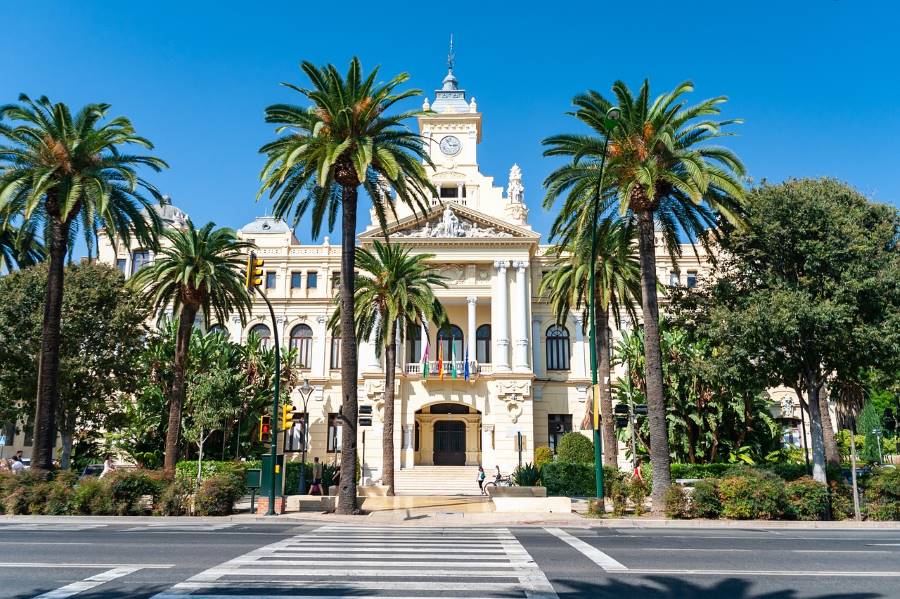
More inside tips to visiting Malaga City and the “Local Spots”
Exploring Malaga City beyond the main attractions can lead to delightful discoveries and a deeper appreciation of the city’s authentic culture. Here are some insider tips for experiencing the local life and hidden gems in Malaga:
El Palo and Pedregalejo Beaches: These charming neighborhoods offer a more relaxed beach experience compared to the crowded Malagueta Beach. Enjoy fresh seafood at local chiringuitos (beachside restaurants) and experience the true coastal lifestyle.
SoHo District: Malaga’s emerging arts district, known as SoHo, is home to vibrant street art, galleries, and cultural events. Stroll through its streets to discover urban art and creativity.
Mercado de la Merced: Visit this bustling local market for a taste of authentic Malaga. You’ll find fresh produce, seafood, cheeses, and tapas stalls, making it an excellent place to sample local cuisine
Teatro Cervantes: Check the schedule for events at Teatro Cervantes, Malaga’s historic theater. It hosts concerts, ballets, and theatrical performances, providing a unique cultural experience.
El Jardín de Cervantes: Located near the Roman Theater, this serene garden offers a peaceful escape from the city’s hustle and bustle. It’s a hidden oasis where you can relax and enjoy some quiet time.
Bodega El Pimpi: A famous local haunt, Bodega El Pimpi is a traditional wine bar known for its Andalusian charm and live music. Try local wines and tapas in a historic setting.
Antigua Casa de Guardia: Visit this historic wine bar, founded in 1840, for a taste of Malaga’s sweet wines. It’s an authentic experience, and the wines are served straight from the barrels.
Montes de Malaga: Take a short drive or bus ride to the Montes de Malaga Natural Park. Here, you can explore hiking trails, enjoy a picnic, and immerse yourself in the scenic beauty of the surrounding hills and forests.
El Rincón de la Victoria: A coastal town just east of Malaga, El Rincón de la Victoria offers beautiful beaches, historic caves, and a quieter atmosphere. It’s an excellent day trip option.
Exploring these off-the-beaten-path spots and experiencing local traditions will allow you to discover the true essence of Malaga and its rich cultural heritage. Don’t be afraid to venture beyond the tourist areas to uncover these hidden treasures.
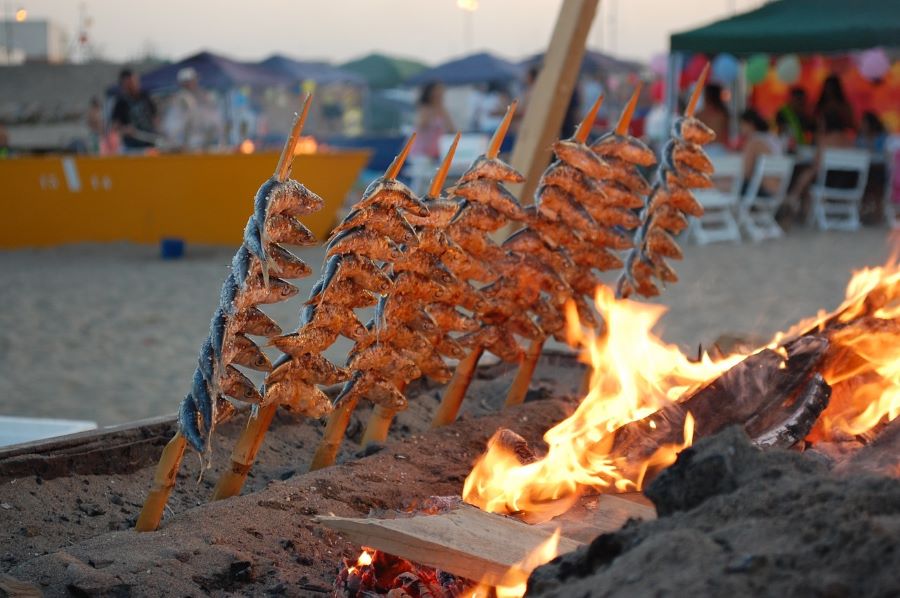
Where to eat in the old town of Malaga
If you are exploring the Old town district, you’ll probably get hungry so we have some fantastic recommendations of places to eat and what they are known for. Check out all these favorite spots below:
Málaga’s Old Town is brimming with fantastic dining options that offer a taste of authentic Andalusian cuisine. Here are some top picks:
El Pimpi
Vibe: – A Málaga institution with a lively, traditional Andalusian atmosphere.
Highlights: – Tapas, local wines, and famous patrons’ autographed wine barrels.
Must-Try – Jamón Ibérico, fried fish, and their sweet Málaga wine.
Casa Lola
Vibe – Bustling tapas bar with a modern twist on classic dishes.
Highlights: – Fresh seafood and innovative small plates.
Must-Try – Boquerones (anchovies), prawn skewers, and the local favorite, tortilla de patatas.
La Taberna del Pintxo
Vibe:- Casual and lively, with an emphasis on pintxos (small snacks) from the Basque region.
Highlights – A wide variety of pintxos served on skewers; grab what catches your eye.
Must-Try – The daily specials and anything with seafood.
Uvedoble
Vibe – A modern, intimate spot that offers a fresh take on traditional tapas.
Highlights – Creative dishes with local ingredients in a cozy setting.
Must-Try – Pork cheek, oxtail burger, and their signature croquettes.
Bodeguita El Gallo
Vibe – Charming, authentic tavern tucked away in a narrow street.
Highlights – Traditional Andalusian dishes with a focus on local flavors.
Must-Try – Salmorejo (cold tomato soup), grilled sardines, and aubergines with honey.
Antigua Casa de Guardia
Vibe: -Old-school wine bar dating back to 1840, offering a glimpse into Málaga’s past.
Highlights – Local wines straight from the barrel and a simple, rustic menu.
Must-Try – Dry and sweet Málaga wines paired with cured meats and cheeses.
Here’s a video tour of a tapa and drink tour in Malaga for inspiration below
Pin and save this post for later

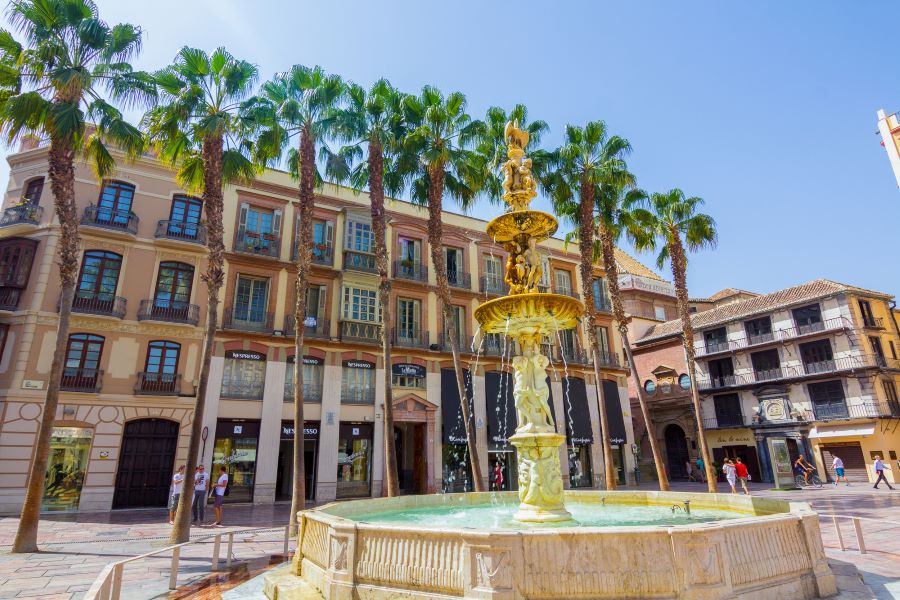
Further Reading – Check out these other Malaga articles
Specialty foods of Malaga, Spain

Conclusion to visiting the best 18 places in Old Town Malaga
Visiting Old Town Malaga is like stepping into a living tapestry of history and culture, old and new combined. This historic district, with its narrow cobblestone streets, ornate buildings, and lively atmosphere, offers a rich and immersive experience that showcases the soul of the city.
As you explore Old Town Malaga, you’ll encounter a myriad of attractions, from the iconic Alcazaba and Gibralfaro Castle to the captivating Picasso Museum. You’ll have the chance to savor traditional Andalusian cuisine at local tapas bars, stroll through picturesque plazas, and admire the intricate architecture of Malaga Cathedral.
Beyond the main attractions, Old Town Malaga unveils its own secrets, from hidden courtyards to bustling markets, providing a sense of authenticity and local life that’s fun to discover even by accident.
Thanks for checking out this post on Visiting Spain and Mediterranean, please come back again for other travels around Spain.

About author – Noel Morata
After relocating from the United States to Andalusia in 2018, I’ve made it my mission to discover every corner of Spain. Based just east of Granada, I’ve spent over 12 months exploring Málaga province, visiting each attraction featured in this guide multiple times across different seasons. My background in Spanish cultural studies and five years of residence in southern Spain have given me unique insights into the region’s historical significance and local customs. I regularly update my guides with the latest information gathered through personal visits and relationships with local tourism officials and finding out what’s new and exciting to visit in each destination.


13 thoughts on “Old Town Malaga”